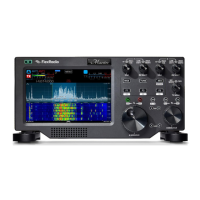FLEX-6000 Signature Series – Maestro User Guide
Copyright 2024 FlexRadio, Inc. All Rights Reserved. | Page 125
27.4 TRANSMITTING ON A TRANSVERTER
When transmissions occur on the transverter, the radio will reconfigure internal relays to connect
the exciter in the FLEX-6000 to the XVTR port on the radio. If a split IF is in use, the RXA or RXB port
may continue to be used for receiving provided that your transverter continues to receive RF (check
with the transverter manufacturer).
When a common IF transverter is used, the XVTR port normally being used for transmitting will be
switched away from the FLEX-6000 SCU and connected to the exciter. As a side-effect, the relay
may connect the SCU to one of the HF antenna ports which causes the Panadapter to show HF
signals in the HF IF band in addition to the transverter band when transmitting.
In addition, when transmitting on a split IF transverter configuration, because the transverter RF
output is low power it will not be dramatically visible on the transverter Panadapter like it is shown
when transmitting on HF at high power.
Both of these conditions during transmission can be quite confusing as they do not accurately
represent the transmitting state of the radio properly. For this reason, the Panadapter will pause
when using IF transverters while transmitting.
27.5 WEAK SIGNAL CONSIDERATIONS
When using Maestro for weak signal operations, three kinds of receiver resources will be in use:
Panadapters, Waterfalls, and Slice Receivers. The noise floor of the Panadapter may be changed to
facilitate seeing signals that are weaker than the “noise floor.” Amateurs generally refer to the
noise floor as the noise floor in a 500Hz bandwidth receiver. For a Maestro Panadapter, the
receiver is variable width for a single “bin” or pixel in your display. The further you zoom in on the
Panadapter, the lower the bin size in use and the lower the noise floor. The processing gain
achieved in this way is 3dB for each reduction in the bandwidth of a bin by two --- or each time the
magnifying glass ‘+’ is depressed. To show this control, tap on the panadapter and it will appear in
the upper right of the panadapter.
On a FLEX-6700 fully zoomed in, the bin size will be 1.5Hz. This represents a 25dB gain over the
500Hz noise floor. The Waterfall and Panadapter both derive data from the same receiver so for
best weak signal viewing, zoom the Panadapter to one of the last few zoom levels. On a FLEX-6500
or FLEX-6300, the minimum bin size is 5.9Hz.
The noise floor of the Slice Receiver is independent of the Panadapter and is adjustable by adjusting
the filter width of the Slice Receiver. Your ears and brain provide a type of signal processing so the
Slice Receiver volume should be adjusted for the best listening experience. In general, the AGC-T
should be set to a fairly low value for best listening on transverter bands. In other words, it should
be adjusted for a relatively quiet receiver.

